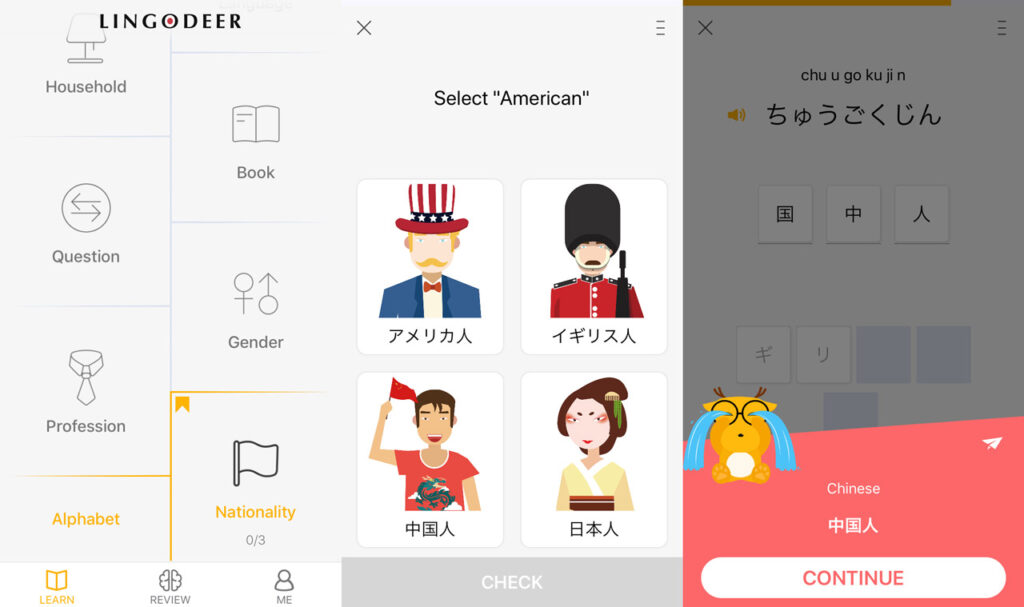🎯 Core Features
- Structured Curriculum & Grammar Focus
- Lessons carefully structured by level (A1–B1), topics, and contain Learning Tips with explanations of grammar—perfect for creating from ground up to intermediate.
- Features a “Test Out” option so you can bypass if you feel certain.
- Alphabet & Writing Practice
- Comes with complete modules for scripts such as hiragana, katakana, Hangul, Pinyin, Arabic, Cyrillic, Thai, etc.
- Has writing drills for Chinese (1,000 characters) and Japanese Kanji (100 characters).
- Interactive Lessons
- Mini-lessons (~5 minutes) consist of diverse exercises: fill-in-blanks, listening, dragging, speaking, typing, image matching.
- HD native-speaker audio for pronunciation and listening practice.
- Review & Reinforcement
- Exclusive Review tab for vocabulary, grammar, and characters, with flashcards and quizzes.
- LingoDeer Plus app provides additional reinforcement in the form of games and spaced repetition exercises.
- Other Features
- Fluent mode (for certain languages) features dialogues, cultural notes, speaking/writing practice.
- Travel Phrasebook: useful for real-life scenarios—food, travel, introductions
- Offline learning supported
📌 Pros & Cons
LingoDeer (Structure & Grammar Focus)
- Strengths:
- Provides clear grammar explanations and logical lesson progression—perfect for grasping language machinery .
- Provides script/character practice (particularly for Asian languages), with native speaker audio throughout .
- Excellent for creating foundation in scripts and grammar, particularly in Japanese, Chinese, and Korean .
- Weaknesses:
- Content levels off at intermediate levels; advanced learners will find less useful.
- Speaking practice is restricted to playback and recording—no live chat or strong speech feedback .
FluentU (Immersion & Video-Based Learning)
- Strengths:
- Boasts a huge database of authentic videos—music, movie scenes, news—with subtitles and quizzes embedded .
- Perfect for visual learners, offering visual context and interactivity .
- Great vocabulary learning through SRS and transcript flashcards .
- Limitations:
- No speech or pronunciation feedback—no voice input or recognition functionality.
- Can seem clunky or outdated, and has no formal lessons aside from videos
💵 Pricing
- Free version offers lessons for alphabet, phrasebook, some lessons, review tools, and some content.
- Premium membership (in-app purchases):
- Monthly: ~$14.99
- Annual: ~$79.99
- Lifetime: ~$159.99
- LingoDeer Plus is a separate paid app with review and drill focus.
🆕 New Language Courses (2024–25)
- Malay, Polish & Turkish were introduced in early 2025—each debuting with a dedicated Travel Phrasebook for speedy on‑the‑go learning .
- Greek & Ukrainian also became available in Spring 2025 (app version 2.99.301, released Mar 31 2025).
- Ongoing expansion with Indonesian, Polish, Malay added incrementally through 2024 .
🔧 Recent App Improvements
From the June 20 2025 developer log:
- Dark mode UI enhanced throughout Android.
- Speech recognition improved, particularly for Japanese and other languages—faster speaking drills as well.
- New option to choose particular words/sentences for personal review drill.
- Test-Out completions now affect streak tallies.
- Course listings reordered to feature popular languages and renamed French versions for clarity.
- Improved explanations of streak features added and several bugs (SRS, lesson summaries, etc.) solved.
💬 Community Feedback & Support
- Users thank LingoDeer for its responsive support staff:
- “I reached out to them recently and was pleasantly surprised at how much they value our feedback… they’ve always replied.”
- However, some are demanding more in-depth content:
- “Most languages such as Malay, Thai, Arabic, Polish etc do not have a B1 level course…Would be wonderful if they all can eventually provide up to B2”
- and observe a change of emphasis:
- “The R&D has apparently moved over to LingoDeer+. They’re introducing new languages while leaving old courses behind.”
🌍 Course Scope & Depth
- LingoDeer now offers 18 courses across 12 target languages (e.g., Arabic, Hindi, Thai, Turkish, Ukrainian, Vietnamese) .
- Core courses typically range from A1–B1, with current efforts to extend intermediate content.
- Unique support for multilingual instruction, allowing studied languages via another (like Japanese lessons in Korean) .
🛠️ User Experience Highlights
- Contextual grammar insights: “Key Points” before each lesson summarize what you’ll learn—highly praised in Korean and other courses.
- Click-to-define vocabulary explains word origins—ideal for languages such as Korean .
- Star word/grammar system: allows users to mark items to come back to.
- Toggle-able immersion mode eliminates translations for challenge .
- Complete offline support with option to download content—handy for holidays or low-connectivity environments .
🌟 What Might Be Next?
- User requests typically call for Nordic & regional languages (e.g., Catalan, Basque, Galician, Norwegian, Finnish).
- Numerous others desire B2-level or Fluent paths through current languages.
- LingoDeer’s staff has mentioned on social media and through support that new courses are in development, but details are not revealed.
✅ Summary
- Strengths: fast course growth, user-responsive support, improved UI (especially speech functionality), offline learning, and considerate grammar contextualization.
- Opportunities: filling out existing courses above A1/B1, introducing a Fluent path for additional languages, and incorporating user-requested languages.



